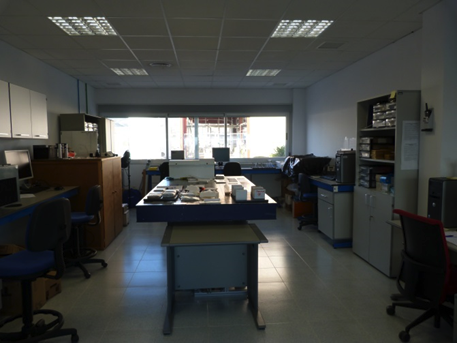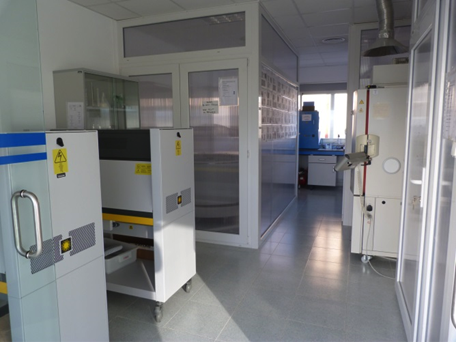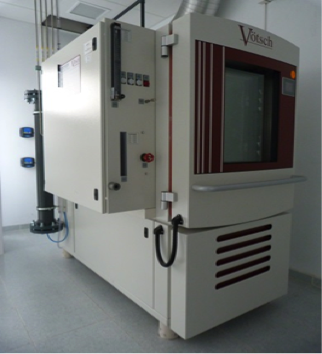

OPAC
Solar reflector durability analysis and optical characterization
This activity line of the PSA Solar Concentrating Systems Unit laboratory is the result of a joint collaborative initiative between CIEMAT and DLR. It is provided with the necessary equipment to completely characterize the materials used as reflectors in solar concentrating systems. This line is devoted to evaluate the characteristic optical parameters of solar reflectors and their possible deterioration. The equipment associated to this activity line allows for both quantitative and qualitative measurement of the reflectance of solar mirrors:
- Three portable specular reflectometers, Devices and Services Model 15R-USB, for measuring specular reflectance at 660 nm at different aperture angles (3.5, 7.5, 12.5 and 23 mrad).
- One portable specular reflectometer, Devices and Services model MWR, for measuring specular reflectance at 460, 550, 650 and 720 nm and at different aperture angles (2.3, 3.5, 7.5, 12.5 and 23 mrad).
- Reflectometer prototype for measuring specular reflectance in a 5 cm diameter with spatial resolution of 10 pixel/mm, which measures at various wavelengths and aperture angles (model SR2, designed and patented by DLR).
- Perkin Elmer Lambda 1050 spectrophotometer, with 150-mm integrating sphere and specular reflectance accessory with 0 to 68° incidence angles (URA).
- Nikon D3 camera and 90 cm Cubalite kit for photos of specular surfaces without parasitic reflections.
- Zeiss Axio microscope model CSM 700 (with magnifications of 5, 10, 20, 50 and 100) for finding the profiles and roughness of highly reflective surfaces.
- Hitachi S3400 electronic scan microscope (SEM) with EDX analysis.
- Parstat 4000 impedance system to analyse the corrosion of reflector materials.
- General Purpose Optical bench as accessory for the Perkin Elmer Lambda 1050 spectrophotometer with advanced features for mounting optical devices for the development of new measurement instruments.
Globally, the equipment associated to this activity line is designed for accelerated ageing tests of solar reflectors with the purpose of predicting in a short time, the behaviour of these materials during their useful lifetime. To do this, the environmental variables producing degradation of solar reflectors when they are exposed to outdoor conditions are applied in a controlled manner, both separately and in combination. The following simulation equipment is available for these accelerated ageing tests:
- ATLAS SC340MH weathering chamber for temperature (from -40 to+120°C), humidity (from 10 to 90%), solar radiation (from 280 to 3000 nm) and rainfall of 340L.
- Vötsch VSC450 salt spray chamber with temperatures from 10 to 50°C (450L).
- Erichsen 608/1000L salt spray chamber with temperatures from 10 to 50°C.
- Two ATLAS UV-Test radiation chambers where UV light (with a peak at 340 nm), condensation and temperature can be applied. One of the chambers also includes rain simulation.
- Hönle UVA Cube Ultraviolet radiation chamber.
- KÖHLER HK300M acid rain chamber, 300 L and temperatures up to 70°C and humidity up to 100%, to apply the Kesternich test.
- SC100 heatable water bath, to perform the Machu test, according to the Qualitest guideline.
- Vöstch VCC3 0034 weathering chamber to test the material resistance against corrosive gasses (335L).
- Ineltec CKEST 300 test chamber for humidity and condensation testing with temperatures up to 70ºC (300L).
- Memmert HCP108 weathering chamber to apply humidity (20-95 %) and temperature (20-90°C with humidity and 20-160°C without humidity).
- Two Nabertherm LT 24/12 and LT 40/12 Muffle Furnaces.
- Control Técnica/ITS GmbH sandstorm chamber with wind speeds up to 30 m/s and dust concentrations up to 2.5 g/m³.
- Erichsen 494 cleaning abrasion device to test the degradation due to the cleaning brushes, with several cleaning accessories.
- Taber 5750 linear abraser to check the materials resistance against the abrasion.
- Lumakin A-29 cross-cut tester to analyse the possible detachment of the paint layers.
- Several devices for thermal cycles specially designed at the PSA.



Along with this indoor equipment, there are a series of outdoor test benches for exposing materials to outdoor weather conditions and comparing their degradation with those found in the accelerated ageing tests, to study the effectiveness of special coatings, to optimize the cleaning strategy and to analyse the soiling rate. In addition, a heliostat test bench was recently installed to test the influence of blocking on the coatings lifetime. Finally, this activity line is also provided with accessories necessary for their proper use, such as two precision scales, a thermos-magnetic stirrer, several driers, a number of tools for manipulating, cutting and polishing reflectors (both first and second surface), instrumentation for measuring pH, conductivity, oxygen, etc.